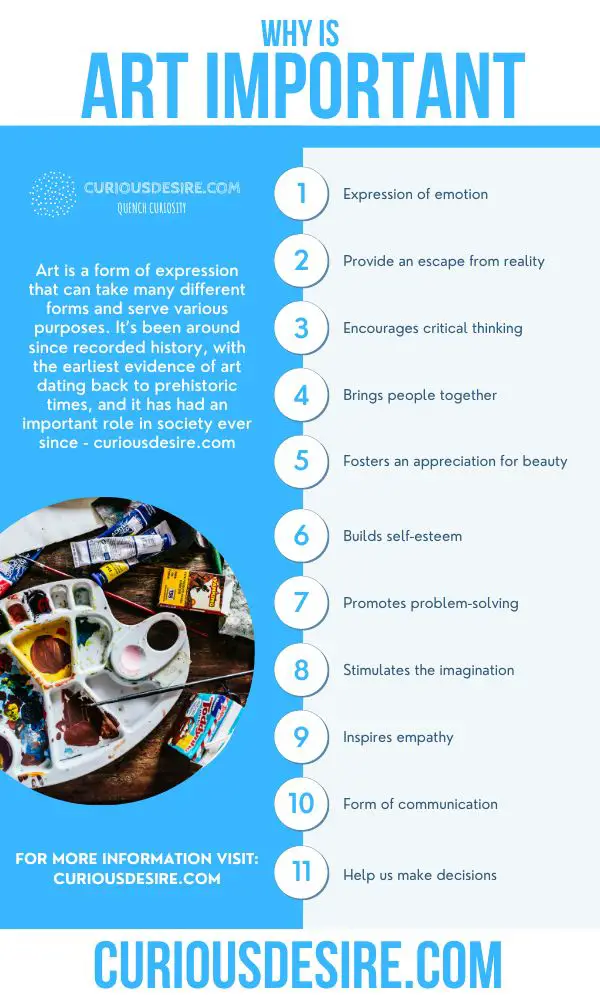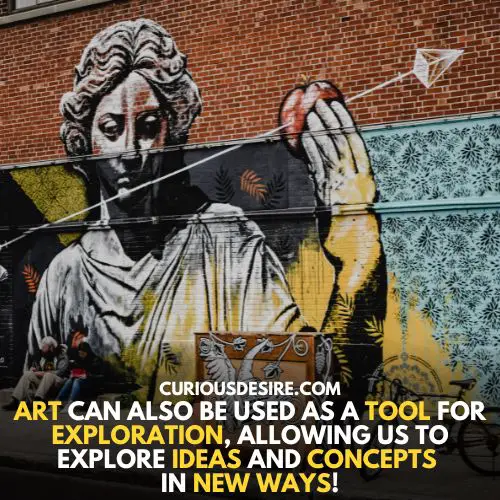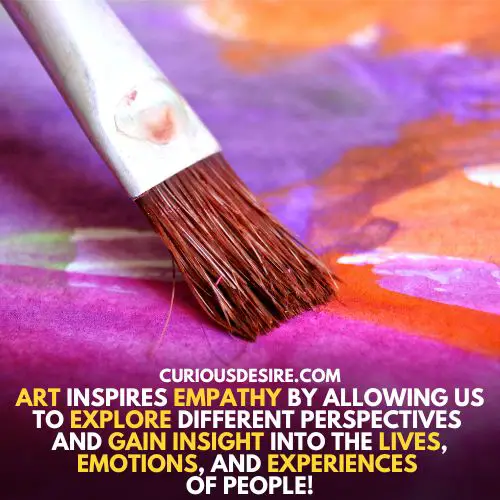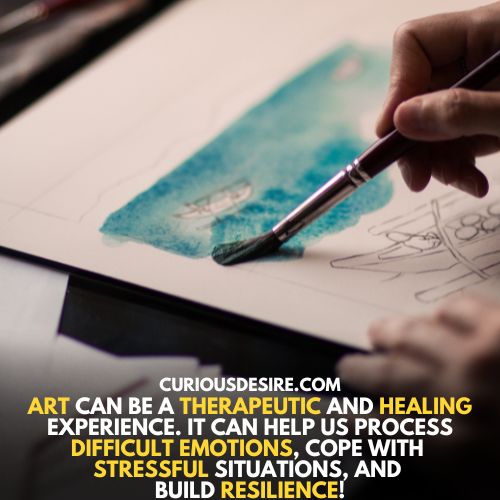Art is a form of expression that can take many different forms and serve various purposes. It’s been around since recorded history, with the earliest evidence of art dating back to prehistoric times, and it has had an important role in society ever since.
In this article, we’ll discuss some reasons for the importance of art in life:
16 Benefits of Art in Life
Art is considered to be a form of self-expression. It allows us to communicate ideas, emotions, and feelings without relying on words. This can help people better understand one another and create a stronger community. However, there is various other importance of art in life which are the following:
1. Art is an expression of emotion
Art can be a way to express emotions and feelings that are too difficult to put into words. Through art, people can communicate and process their thoughts and feelings in a non-verbal way.
Art has the unique power to express emotion in ways that words simply cannot. It can be both a powerful and therapeutic tool for those looking to communicate their innermost thoughts and feelings. It can also provide insight into emotions that we may not understand on our own.
Art is a visual representation of our internal experiences and is often used as a tool for therapy and self-exploration.

2. Art can provide an escape from reality
The importance of art in life cannot be neglected. Art can be a way to take a break from the everyday stresses of life and find solace in an imagined world. Whether it’s through painting, writing, or another form of art, creating art allows us to explore our own thoughts and feelings without the pressure of reality.
Art provides an outlet for creative expression and can serve as a form of meditation or relaxation. It’s like taking a mental break from life, allowing us to escape into our own worlds for a short period of time.
3. Art encourages critical thinking
Creating art requires problem-solving, creativity, and critical thinking. It can also be used as a tool for exploration, allowing us to explore ideas and concepts in new ways.
Art encourages us to think beyond what is immediately visible and consider the implications of our work from different perspectives. By engaging with art, we can practice creative problem-solving and hone important skills such as empathy, communication, and collaboration.

4. Art brings people together
Art can be used as a form of shared expression, allowing us to connect with one another through the experience of making art. It can bring people from different backgrounds and cultures together in a way that language often cannot.
Whether it’s creating artwork with friends or attending an art show, art has the power to bridge gaps between people and form meaningful connections.
By exploring different forms of art, we’re able to discover similarities and make connections between things that may not have been obvious before. This kind of learning helps us form a deeper understanding of the world around us
5. Art fosters an appreciation for beauty
Art often encourages us to take a step back and appreciate the things around us in a new way. By creating or engaging with art, we can learn to appreciate beauty in ways we may not have considered before.
Art can be an opportunity to reflect on the world around us and foster a sense of appreciation for the beauty that exists in our lives. It can also help us develop a greater understanding of ourselves and the world at large.
Suggested Readings
6. Art builds self-esteem
Creating art can give us a sense of accomplishment and pride in our work. By engaging with art and expressing ourselves, we build confidence and become more open to trying new things and taking risks.
Art also encourages self-reflection, allowing us to gain insight into who we are and how we feel about ourselves. This can be an invaluable tool for building self-esteem and a positive outlook on life. Art has the potential to make us better communicators, problem-solvers, and thinkers. In a world of uncertainty and stress, art can be a powerful tool for connection and self-expression.
7. Art promotes problem-solving
Art can be a powerful tool for problem-solving, providing us with the ability to think outside of the box and come up with creative solutions to difficult problems. By engaging in art-making activities, we can practice our visual-spatial skills, increase our awareness of different perspectives, and develop our creativity.
The creative process of art-making can also help us develop problem-solving skills, as we learn to identify the underlying causes of a problem and strategically approach it from different angles.
8. Art stimulates the imagination
Whether we’re creating art or viewing the work of others, it encourages us to use our imaginations and take a mental journey into new places.
Art plays an important role in stimulating the imagination. Through art, we can explore different worlds and possibilities, allowing us to think outside the box and come up with creative solutions to everyday problems. Art encourages us to look at life from different perspectives, expanding our minds and broadening our understanding of the world around us.
When creating art, we can also tap into our own inner worlds, exploring our feelings and emotions safely and constructively. This kind of self-expression can help us better understand ourselves and develop important skills such as communication, empathy, and resilience.
9. Art inspires empathy
Art has the power to inspire empathy by allowing us to explore different perspectives and gain insight into the lives, emotions, and experiences of people from all walks of life. Through art, we can develop a greater appreciation for those who are different from us and learn to connect with them on a deeper level.
When engaging with art, we can also practice our own self-reflection, gaining insight into our own feelings and emotions and developing important skills such as communication and empathy. Art can help us become more open to understanding the feelings of others and connecting with them on a deeper level.

10. Art is a form of communication
Art is an incredibly powerful form of communication. It has the ability to evoke emotion and create connections between individuals and cultures, while also providing an avenue of self-expression. Through art, we can explore different perspectives, express our feelings and identities, and build meaningful relationships.
We can use art to express ideas, stories, emotions, and experiences in a captivating way, allowing us to make an impact on our audience. Whether we’re creating art or viewing the work of others, it can be a powerful tool for communication and self-expression.
By working together on art projects, we can learn important communication and teamwork skills that can be applied in many other areas of life.
11. Art is healing
Art can be a profoundly therapeutic and healing experience. It has the power to help us process difficult emotions, come to terms with stressful situations, and build resilience. Research has shown that engaging in art-making activities can help reduce symptoms of anxiety, depression, and other mental health disorders.
The creative process of making art allows us to explore our inner worlds, express our feelings and emotions, and gain a better understanding of ourselves.
By engaging in art-making activities, we can practice self-reflection and gain insight into our own thoughts and feelings. Art can also provide us with an opportunity to connect with others on a deeper level, build meaningful relationships, and create positive changes in our lives.

12. Art is beautiful
Looking at art can be enjoyable and uplifting, while also encouraging us to think differently about the world around us.
Art is beautiful in a multitude of ways. From the works of renowned painters, such as Vincent van Gogh and Monet, to contemporary street art and graffiti, art has the power to evoke emotion, delight our senses and spark creativity.
13. Art is educational
Art is more than just a form of expression; it can also be an incredibly powerful learning tool. Engaging with art can open up new ways of understanding, allowing us to explore different cultures, histories, and perspectives. By examining works of art from different time periods, we can gain insight into the values and beliefs of past societies as well as our own.
Art can also teach us important lessons about ourselves and the world around us, from learning how to be creative and express ourselves to gaining an appreciation for diversity and understanding different perspectives.
14. Art can help us make decisions
Art can be a powerful tool for making decisions. By engaging with art, we are able to tap into our own inner wisdom and gain insight into our own thoughts, feelings, and motivations.
Through this process of self-reflection, we can uncover the values that drive us and make informed decisions based on our own authentic desires.
Suggested Readings
15. Art fosters innovation
Art has the power to foster innovation, allowing us to explore different ways of thinking and come up with new ideas. By engaging with art, we can cultivate our creativity, expand our horizons and express ourselves in unique ways.
Art encourages us to think outside the box and explore new possibilities, inspiring us to push the boundaries of what is possible.
16. Art is a form of activism
Art has the power to raise awareness and bring attention to important social issues. From political cartoons to street art, art can be used as a powerful tool for activism, helping us amplify our voices and create positive change in our communities. By engaging with art, we can participate in meaningful dialogue, explore our own values, and take action to make a difference in the world.
Art is an important part of life that can have a profound impact on the lives of both the individual and society as a whole.
How Art can Improve your Quality of Life – Make Life Better
Art can bring joy and a sense of fulfilment in your life. It can also be used as a form of self-expression, and it’s an activity that can help to improve your mental well-being. Art has the potential to reduce stress, boost creativity, provide comfort and encourage relaxation.
It can help to connect you with other people and give you a sense of purpose and accomplishment. Art can also be used to help us express our feelings, tell stories, share experiences and document history. Art is a powerful tool that not only brings beauty into the world but helps us develop empathy, problem-solving skills, creative thinking abilities and self-discovery capacities.
Art encourages us to view things from different perspectives and to think outside the box. It motivates us to form connections, inspires imagination and helps us process emotions. Art can also provide an educational experience, foster innovation and promote collaboration among individuals. All in all, art is an invaluable resource that can improve our quality of life in many ways.
Conclusion
Art is a fundamental part of life that can bring joy, meaning, and beauty into the world. It’s an activity that encourages creativity, self-expression, empathy, problem-solving skills and innovation. Art also provides comfort, teaches us about history and culture, helps us make decisions and fosters collaboration among individuals.
As such, art has the potential to improve our quality of life in a number of ways. Therefore, it’s essential that we continue to promote and celebrate art in all its forms. Art has the power to enrich our lives in a variety of ways, so let’s embrace it.